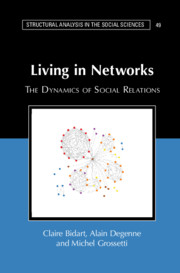Book contents
- Living in Networks
- Structural Analysis in the Social Sciences
- Living in Networks
- Copyright page
- Contents
- Figures
- Tables
- Preface
- Acknowledgments
- Introduction
- Part I Foundations of a Sociology of Relational Dynamics
- Part II Networks and Their Dynamics
- Part III Networks and Social Worlds
- 8 Networks Have a Spatial Dimension
- 9 Soft Segregation
- 10 Relationships and Networks As Resources
- 11 Unequal Networks
- 12 Networks Online and Offline
- Conclusion
- References
- Index
- Structural Analysis in the Social Sciences
9 - Soft Segregation
from Part III - Networks and Social Worlds
Published online by Cambridge University Press: 27 October 2020
- Living in Networks
- Structural Analysis in the Social Sciences
- Living in Networks
- Copyright page
- Contents
- Figures
- Tables
- Preface
- Acknowledgments
- Introduction
- Part I Foundations of a Sociology of Relational Dynamics
- Part II Networks and Their Dynamics
- Part III Networks and Social Worlds
- 8 Networks Have a Spatial Dimension
- 9 Soft Segregation
- 10 Relationships and Networks As Resources
- 11 Unequal Networks
- 12 Networks Online and Offline
- Conclusion
- References
- Index
- Structural Analysis in the Social Sciences
Summary
The game of affinities, which, depending on the context, favors more or less the establishment of relationships with people sharing similar characteristics, is discussed here. We begin with the formation of couples and the well-studied phenomenon of "homogamy," and then broaden the focus to its equivalent for general social relationships, "homophily." Social inequalities leave their mark on the characteristics of networks, on their arrangements with social circles, and on the evolutions of the interpersonal relationships that compose them. Even the elective affinities that we would like to believe as "free" of these burdensome social categories are in part subject to them. This chapter describes what can be called "soft segregation," that is, the fact that freely chosen relationships can paradoxically contribute to the fragmentation of the social world.
- Type
- Chapter
- Information
- Living in NetworksThe Dynamics of Social Relations, pp. 210 - 230Publisher: Cambridge University PressPrint publication year: 2020

